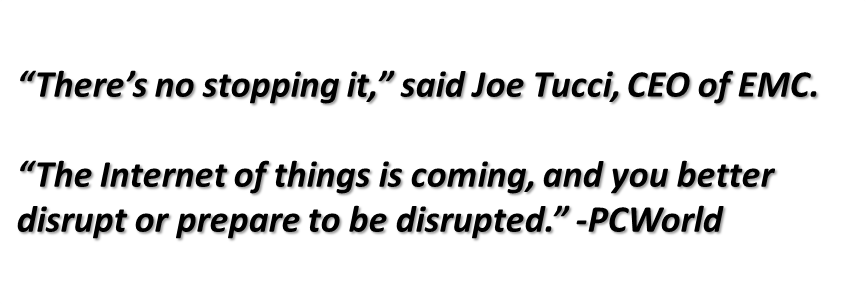I just returned from Barcelona, Spain where the largest service provider event of the year was held: Mobile World Congress 2014. A year ago, not long after joining EMC, Paul Maritz and I attended MWC2013 based on a view that the service provider and off-premise ecosystem would become increasingly important to the EMC federation of businesses (EMC, VMware, Pivotal and RSA). We met with most of the major telecom companies in the world and, universally, they recognized the value of the EMC focus on driving cloud technology and our new focus on building a platform for big data, analytics and modern applications. As I mentioned last year, we left exhausted but excited by the validation of our EMC focus.
This year the activity level was an order of magnitude higher. EMC, VMware and Pivotal were all present. In addition to Paul Maritz and me, VMware CEO Pat Gelsinger and EMC Chairman and CEO Joe Tucci also attended.
On Wednesday, Joe gave a keynote address that covered the shift to the third platform and how this will result in hundreds of billions of connected devices, the Internet of Things, and millions of new applications. The enabling trends are Cloud, Social, Mobile and Big Data. A key takeaway was that this is inevitable and will disrupt industries.
Beyond sharing our view, Joe invited the industry to establish a portable and agile cloud experience by joining the Cloud Foundry community. On Monday, Pivotal announced that Cloud Foundry has moved to a true, open source foundation with the initial members including IBM, HP, Rackspace, and SAP. Many global service providers are already engaged, including NTT, Swisscom, Centurylink, Verizon, and CSC. Joe’s message was clear: the industry needs cloud portability, agility, and an open cloud operating system. Cloud Foundry is the best way to achieve this critical objective.
One of the most tangible examples of the traction we are making in the service provider’s future was Joe’s discussion of the Real Time Intelligence (RTI) solution Pivotal has created. We had an early prototype of this offering at MWC2013 and were looking for service provider partners to work with in moving it to reality. We ended up with a long list of operators looking to engage and we began that process. The leading partner for this effort was Vodafone. Fast forward to 2014: we now have the RTI system in Vodafone’s live wireless networks and it has been productized.
RTI is a new kind of real time big data platform for a wide range of environments including telecom operators. The RTI system is based on the Pivotal One technologies and provides the ability to access and reason over large, diverse data sets ranging from subscriber databases to billing systems and network information. We then add the Pivotal in-memory real-time analytics to the system to be able to capture and process huge volumes of events coming from the carrier infrastructure. In the Vodafone example, the system ingests over a million events per second collected from the signaling stream of the wireless network. Finally the RTI system is organized as a platform that allows rapid development of new big data applications.
In fact, in the Vodafone booth, their Spanish operation wanted to show RTI being used to track and model people and traffic flow over Barcelona in real time. Since their RTI platform was already in place, a new application was developed and deployed in only a few weeks. The system worked by tracing the Vodafone ES employees as they moved throughout the city. You could see in real time how they moved and where they clustered, visualized against 3D maps of the city. In one very interesting view you could see when anonymized employees showed up at the MWC venue and how many were present at any time in the specific halls and sub areas of the site. You could also see where they came from, what parts of the city they passed through, and, given a large enough data set, even visualize population flow in real time to better understand congestion and transportation performance.
The key difference between RTI and the existing operator solutions is that RTI creates a common way to collect, manage and reason through your big data and real time data via a modern platform that is optimized for new application development and diverse data sources. We know of hundreds of use cases that RTI can be leveraged to address (from churn management to NPS score visibility and network optimizations)… as a single uniform platform with each use case just means a new application. From concept to product in a little over a year was pretty good progress and exciting to see.
Joe closed out by highlighting the EMC progress in building clouds, driving the evolution of storage to accommodate cloud models, and evolving the mobile technology space. He showed off our mobile file sync and share collaboration technology, Syncplicity. Unlike consumer oriented offerings, this system not only provides slick, mobile friendly integration of the user experience but also allows for customer choice of where to store the data (in the cloud, in their data center, hybrid, etc.). In addition to Syncplicity, Joe highlighted VMware’s announced acquisition of Airwatch, which gives VMware the leading technology in Enterprise Mobility management and adds to the already broad end user computing capability within the VMware portfolio. Finally, he told the audience how EMC is helping them manage data at Exabyte scale. It took 26 years to ship a total of 1EB of storage. Last year, EMC shipped that much in a month. Now, we are seeing some individual deals that approach an Exabyte in size.
What a difference a year makes! We believe that IT and Telecom are coming together and that EMC technical capability is at the core of this new environment. Mobile World Congress 2014 and the significant visibility of the EMC federation certainly reinforce this.
